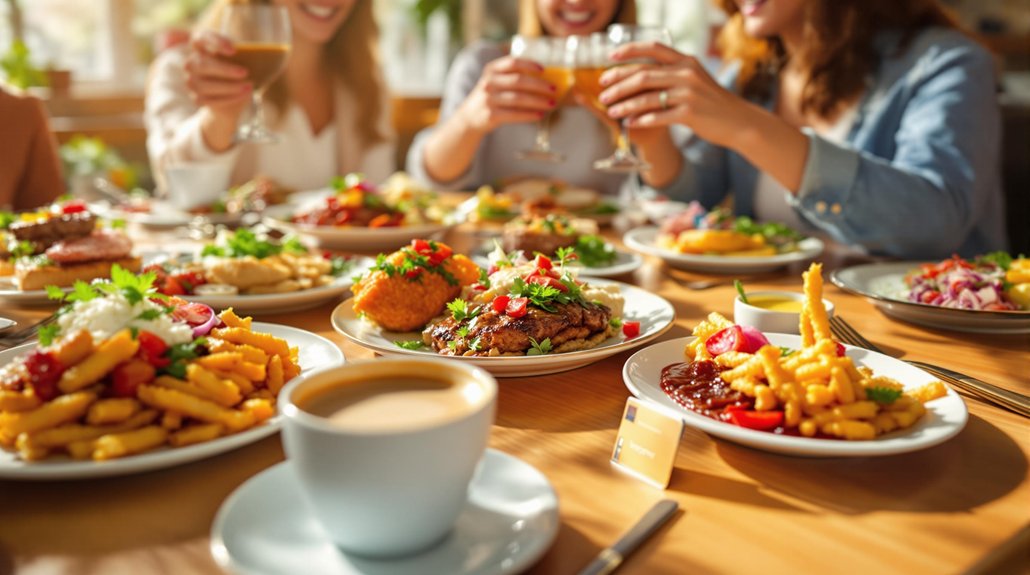Restaurants should use loyalty incentives to build lasting relationships and encourage repeat visits. These programs create a sense of belonging and enhance your dining experience, making you feel valued. With options like points systems, tiered rewards, and exclusive access, you’re more likely to spend on new dishes and bring friends along. Ultimately, loyalty programs keep you connected and satisfied, allowing restaurants to thrive. Discover how implementing effective strategies can boost this connection even further.
Benefits of Customer Loyalty Programs
 .
.
When you think about what keeps customers coming back to a restaurant, loyalty programs often come to mind, and for good reason. These programs create a sense of belonging, making patrons feel valued and appreciated.
When you reward customers for their repeat visits, you’re not just encouraging them to dine again; you’re building a lasting relationship. This connection enhances their overall experience, leading to positive word-of-mouth marketing.
Plus, loyal customers tend to spend more, as they’re more likely to try new dishes or indulge in special offers. By investing in loyalty programs, you’re fundamentally setting the stage for consistent revenue. Additionally, these programs can amplify customer engagement by creating a community around your restaurant, making your establishment a preferred choice in a crowded market.
Loyal customers not only return but also spend more, exploring new dishes and special offers that boost your revenue.
Ultimately, these initiatives foster a community around your restaurant, making your establishment a preferred choice in a crowded market.
Types of Loyalty Incentives
There are numerous types of loyalty incentives that can transform your restaurant's customer experience and bolster repeat visits.
One popular option is the points system, where customers earn points for every dollar spent, redeemable for discounts or free items.
Another effective method is punch cards, offering a free meal after a certain number of visits.
You might consider tiered rewards, encouraging customers to reach new levels for better perks.
Exclusive access to events or menu items can also create excitement and a sense of belonging.
Finally, referral bonuses encourage customers to bring friends, expanding your reach. Additionally, incorporating family and kids promotions can further enhance loyalty by appealing to parents dining with their children.
How Loyalty Programs Increase Customer Retention
 .
.
Loyalty programs do more than just reward customers; they create a bond that keeps diners coming back for more. When you participate in a loyalty program, you feel valued and appreciated, turning a simple meal into a memorable experience.
This sense of belonging encourages you to return, knowing that your loyalty will be recognized. As you accumulate points or rewards, the anticipation of your next visit grows, nurturing a habit that benefits both you and the restaurant.
Plus, these programs often offer personalized incentives, which makes you feel special and understood. Ultimately, by fostering this connection, restaurants can greatly boost customer retention, ensuring that you’ll keep choosing them over the competition time and again. Additionally, successful loyalty programs can contribute to significant sales growth, demonstrating their impact on a restaurant's bottom line.
Strategies for Implementing Effective Loyalty Incentives
To create a successful loyalty program, understanding your customers’ preferences and behaviors is essential. Start by collecting data through surveys and feedback; this insight helps tailor incentives that resonate.
Consider tiered rewards that motivate customers to reach new levels, such as exclusive discounts or special menu items for frequent visitors. Make the sign-up process simple and engaging—nobody wants to jump through hoops just to join!
Use digital platforms, like apps or social media, for easy tracking and communication. Finally, personalize your outreach; a birthday surprise or a thank-you note can make customers feel valued. Additionally, leveraging hidden advantages can help you stand out in a competitive market and enhance your loyalty program's effectiveness.
Measuring the Success of Loyalty Programs
 .
.
While you may have implemented a fantastic loyalty program, measuring its success is essential to understanding its impact on your business. Start by analyzing key metrics, such as customer retention rates and the frequency of repeat visits.
Look at the average spending per visit before and after the program’s launch. Don't forget to gather customer feedback; their insights can reveal what’s working and what’s not. Use tracking tools to monitor engagement levels and participation rates, too.
Analyzing average spending and gathering customer feedback are crucial for assessing your loyalty program's success.
You might also consider comparing your performance against industry benchmarks. By regularly reviewing these data points, you'll gain a clearer picture of your program's effectiveness. Ultimately, this information can guide your future strategies, ensuring your loyalty program continues to thrive and benefit your restaurant. Additionally, high turnover rates can impact your restaurant's ability to deliver consistent customer experiences, making it vital to retain loyal customers through effective loyalty incentives.
Frequently Asked Questions
How Do Loyalty Programs Impact Overall Restaurant Profitability?
Loyalty programs boost your restaurant’s profitability by encouraging repeat visits, increasing customer retention, and enhancing average transaction values. When customers feel valued, they’re more likely to return, ultimately driving your revenue growth and long-term success.
Can Loyalty Programs Be Customized for Different Customer Demographics?
Absolutely, you can customize loyalty programs to fit different customer demographics. By analyzing preferences and behaviors, you’ll create targeted rewards that resonate with various groups, enhancing engagement and boosting overall satisfaction.
What Technology Is Needed to Manage Loyalty Programs Effectively?
To manage loyalty programs effectively, you’ll need a robust customer relationship management system, mobile app integration, and data analytics tools. These technologies help track customer behavior, streamline rewards, and personalize experiences to boost engagement.
Are There Any Legal Considerations for Implementing Loyalty Programs?
When implementing loyalty programs, you’ve gotta consider regulations around data privacy, advertising, and consumer protection. Guarantee you comply with local laws to avoid potential legal issues that could impact your program’s success and reputation.
How Often Should Loyalty Rewards Be Updated or Changed?
You should update loyalty rewards regularly, ideally every few months, to keep customers engaged and excited. Changing rewards helps maintain interest and encourages repeat visits, ensuring your program remains fresh and appealing to patrons.




